The Canary Islands, a Spanish archipelago located in the Atlantic Ocean, south of Spain, are a world-renowned tourist destination. With its subtropical climate, stunning landscapes, golden sand beaches and rich history and culture, the Canary Islands offer a unique experience for those looking for an unforgettable spring getaway.
The Canary archipelago consists of 8 islands of volcanic origin: Gran Canaria, Fuerteventura, Lanzarote, La Graciosa, Tenerife, El Hierro, La Gomera and La Palma. These islands are separated by two provinces, the first four islands named above are part of the province of Las Palmas de Gran Canaria and the rest are part of the province of Santa Cruz de Tenerife.
In this article we will explore these Spanish islands a little more, their culture and gastronomy and the places to highlight on each of the islands.
History and culture of the Canary Islands
The Canary Islands, located in the middle of the Atlantic Ocean, have a history that goes back millennia. Before the arrival of Europeans in the 15th century, these islands were inhabited by the Guanches, a people of Berber origin who left a unique cultural and archaeological legacy. The Guanches lived in an organized social system, with an economy based on agriculture and livestock, and their presence can be seen in a series of archaeological sites scattered throughout the islands.
The arrival of the Spanish conquistadors in the 15th century marked a turning point in the history of the Canary Islands. Under Spanish rule, the islands became a strategic point on trade routes to the New World, leading to the construction of a series of forts and colonial buildings to protect and administer the territory.

One of the most outstanding examples of colonial architecture in the Canary Islands is the old town of La Laguna, in Tenerife. Declared a World Heritage Site by UNESCO in 1999, this charming colonial town preserves its original layout and is full of historic buildings dating from the 17th and 18th centuries. Spanish colonial architecture mixes with local influences to create a unique and charming atmosphere that attracts visitors from all over the world.
In addition to its rich history, the Canary Islands are also known for their vibrant culture. Music and dance play an important role in the daily lives of Canarians, with festivals and events celebrating the islands' rich cultural heritage. The timple, a small string instrument similar to the guitar, is emblematic of Canarian music and can be heard throughout the region.
Geography and climate of the Canary archipelago
The archipelago of the Canary Islands, located in the middle of the Atlantic Ocean, is a geographical paradise of eight islands, each of these islands has a unique geography that offers a varied experience for visitors. From steep mountains, endless dunes of golden sand, turquoise waters, deserts, lush green forests and miles of black and white sand beaches, each of these islands has landscapes that seem straight out of a movie.
The climate of the Canary Islands is another of its great attractions. With an average temperature ranging between 20 and 25 degrees Celsius during spring, and a cool breeze blowing from the Atlantic Ocean, the climate is ideal for enjoying outdoor activities and exploring the diversity of landscapes that the archipelago offers. The Canary Islands are known as "the islands of eternal spring" due to their mild and pleasant climate all year round, making them a popular destination for those looking to escape the cold winter or the sweltering heat of summer.
The essentials of each island of the Canary Archipelago
The Canary Islands archipelago, located in the Atlantic Ocean, offers an incredible variety of landscapes and activities to explore on each of its eight main islands. From dream beaches to volcanic landscapes and spectacular hiking routes, here is a guide to the essential things to see and do on each Canary Island:
-
Tenerife:
- Climb Teide: Visit the Teide National Park and climb the highest peak in Spain, the Teide volcano, to enjoy spectacular views of the island and its surroundings.
- Explore the capital: Stroll through the historic streets of Santa Cruz de Tenerife and discover its charming buildings, squares and shops.
- Whale Watching: Embark on a whale and dolphin watching excursion from the port of Los Cristianos and marvel at the marine life that inhabits the waters near the island.
- Explore Orotava: a neighborhood in the middle of a beautiful green valley that will surprise you with the facades of its houses and its streets decorated with green nature and flowers.
- Enter the Anaga Natural Park: a landscape of mountains, forests and green valleys that consists of the largest amount of endemism in Europe.
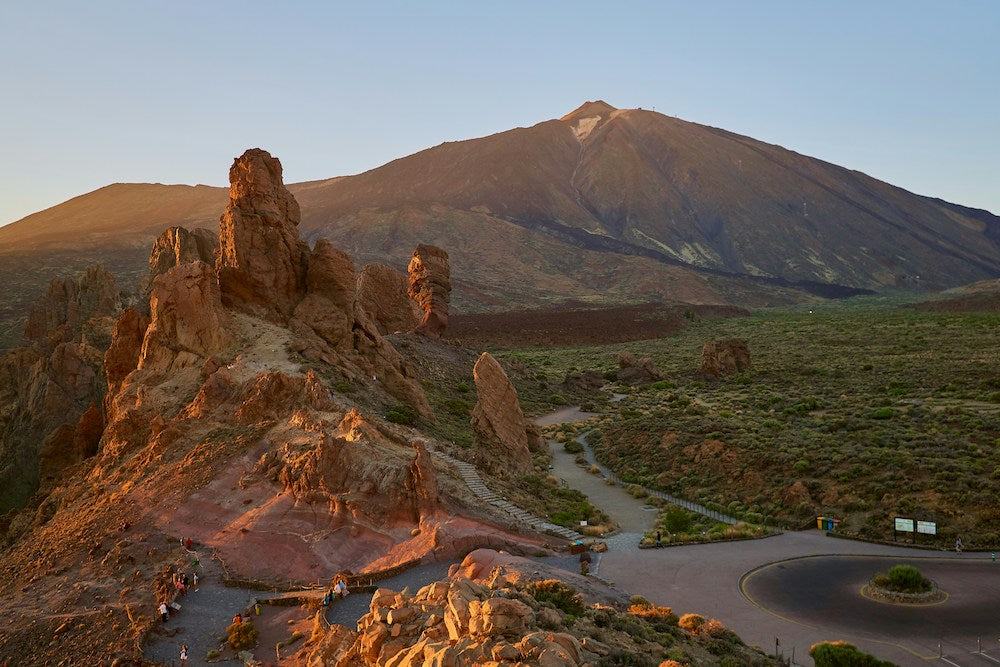
-
Gran Canaria:
- Maspalomas Dunes: Discover the impressive golden sand dunes in Maspalomas and enjoy a walk through this spectacular desert landscape.
- Visit the Cueva Pintada: Explore the Cueva Pintada Archaeological Park in Gáldar and marvel at the ancient cave paintings found in this cave.
- Town of Teror: Visit the charming town of Teror, known for its traditional Canarian architecture and its impressive basilica.
- Discover the little town of Agaete: with its port that connects it with the neighboring islands, this small town in the north of the island will make you feel like you are in the same streets of Greece. In addition to the wide range of restaurants with typical fresh local products that will leave you wanting more.
- Explore the town of Tejeda: named one of the most beautiful in Spain and which, without a doubt, will leave you fascinated with its views of the entire island.
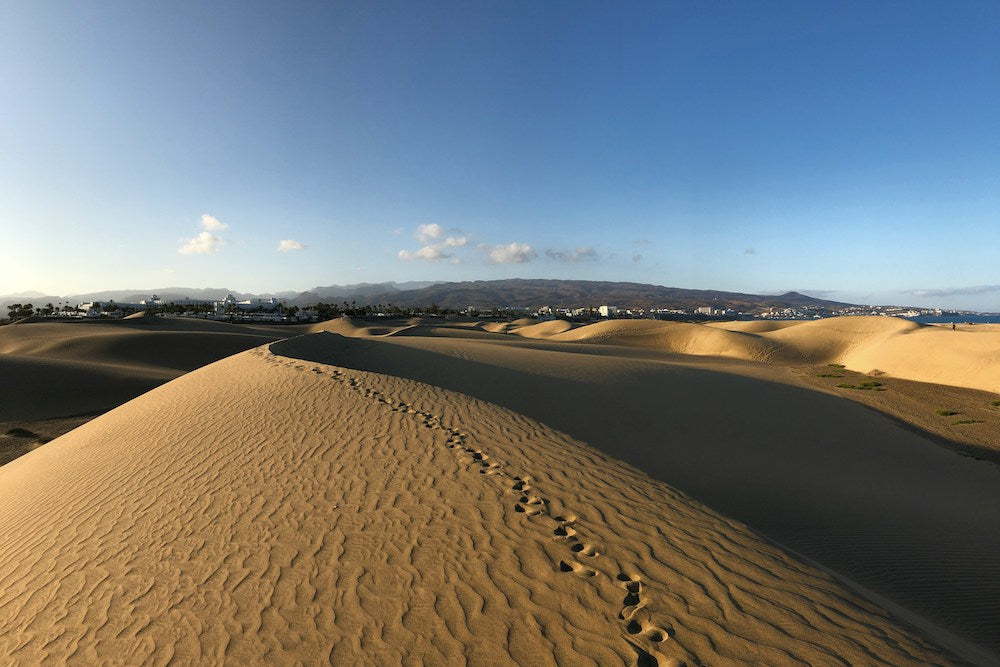
-
Lanzarote:
- Timanfaya National Park: Explore this unique lunar and volcanic landscape in Timanfaya, where you can see geysers, craters and lava mountains.
- Jameos del Agua: Descend into the volcanic caves of Jameos del Agua and marvel at the natural beauty and ingenious architecture of this place.
- La Geria: Visit the La Geria wine region and discover how grapes are grown in volcanic soils, as well as tasting unique local wines.
- The Peasant House Museum: a work by César Manrique that will take you on a tour of the crafts, agriculture and architecture of the islands.
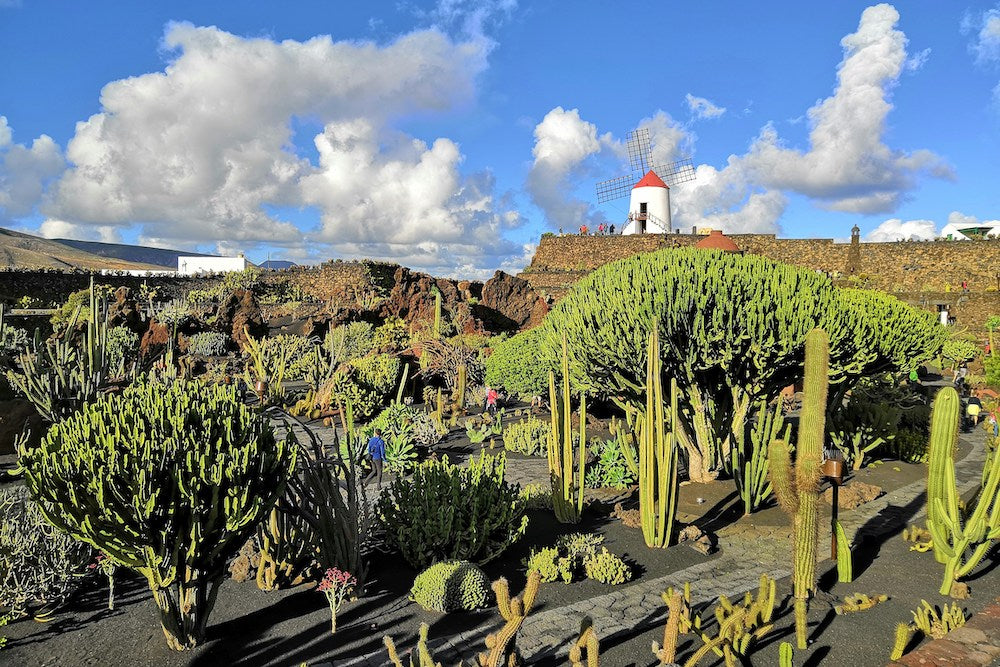
-
Fuerteventura:
- Cofete Beach: Enjoy the tranquility and unspoilt beauty of Cofete Beach, one of the most impressive beaches on the island.
- Corralejo: Explore the sand dunes of Corralejo and relax on the beautiful beaches of this lively coastal town.
- Isla de Lobos: Take a ferry excursion to Isla de Lobos and discover its impressive natural landscapes and crystal-clear waters ideal for diving and snorkeling.
- Visit the town of Betancuria: the most beautiful on the island and from the road to it along a winding road, it gives you impressive views.
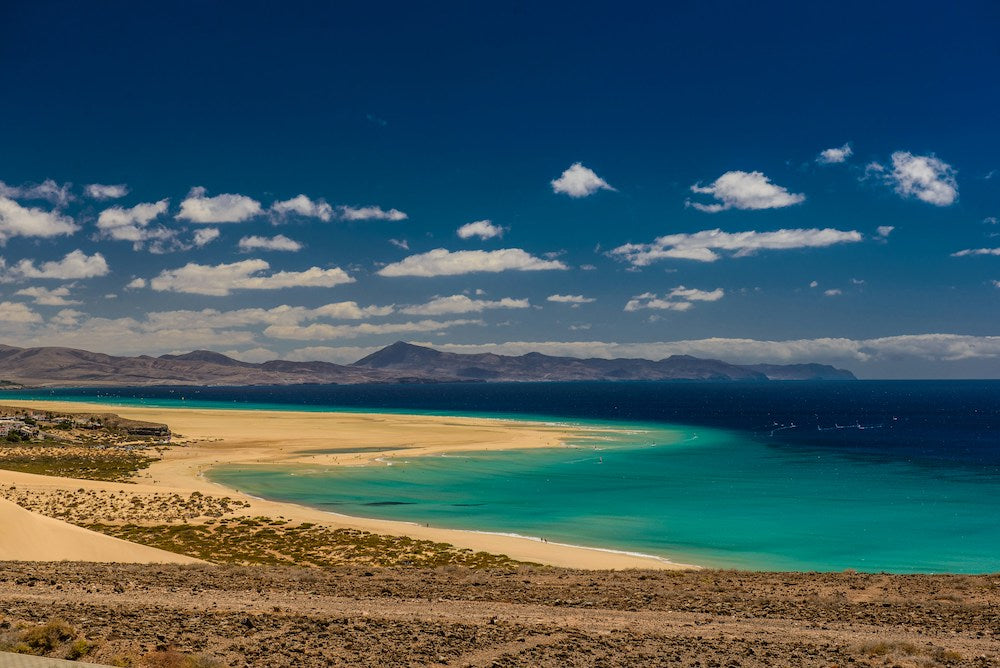
-
La Palma:
- Volcano Route: Hike the Volcano Route in the Caldera de Taburiente National Park and marvel at the island's volcanic landscapes and impressive ravines.
- Roque de los Muchachos Observatory: Visit the Roque de los Muchachos Observatory and enjoy a unique view of the starry skies from the highest point of the island.
- Cascada de los Tilos: Discover the impressive Cascada de los Tilos in the La Palma Biosphere Reserve and enjoy a refreshing swim in its crystal-clear waters.
- Mirador del Roque de los Muchachos: is located at the highest point of the island and offers views of the entire island and even, with ideal conditions, the neighboring island.

-
La Gomera:
- Garajonay National Park: Explore the lush laurel forest of this UNESCO World Heritage park, and enjoy stunning panoramic views from its viewpoints.
- Valle Gran Rey: Visit the charming town of Valle Gran Rey and relax on its beautiful black sand beaches, ideal for swimming and sunbathing.
- Mirador de Abrante: Take in the stunning views of the Vallehermoso Valley from the Mirador de Abrante and enjoy a unique dining experience at its famous restaurant overlooking the cliff.

-
El Hierro:
- Charco Azul: Enjoy a relaxing day at Charco Azul, a series of natural pools with crystal-clear waters on the north coast of the island, ideal for swimming and snorkeling.
- Mirador de La Peña: Take in the spectacular panoramic views of El Hierro from the Mirador de La Peña, designed by artist César Manrique, and enjoy a traditional meal in its restaurant with views.
- El Sabinar: Explore the ancient juniper forest in El Sabinar and marvel at these twisted and sculptural trees that are a true natural jewel of the island.

-
La Graciosa:
- Playa de las Conchas: Relax on the stunning Playa de las Conchas, known for its crystal-clear waters and spectacular views of the nearby islets.
- Point del Pechiguera Lighthouse: Visit the Point del Pechiguera Lighthouse and enjoy impressive panoramic views of La Graciosa, Lanzarote and Fuerteventura from this privileged observation point.
- Diving and Snorkeling: Explore the incredible seabed that surrounds La Graciosa and discover an incredible variety of marine life while you dive or snorkel in the island's crystal clear waters.
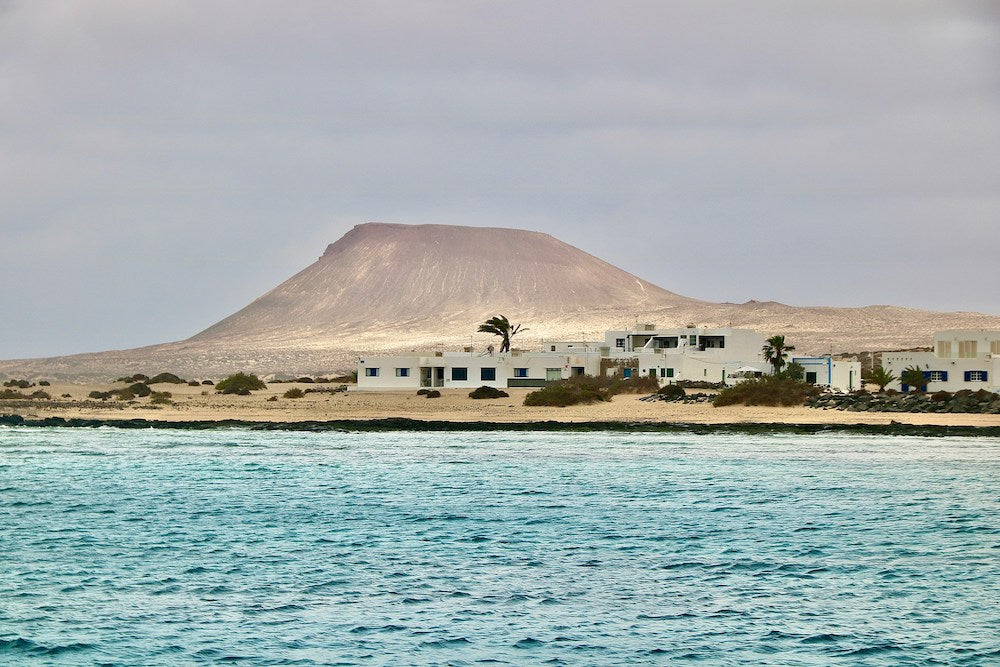
Dream beaches in the Canary Islands
The beaches of the Canary Islands are truly a natural treasure, and their diversity is simply impressive. From white sand beaches and crystal clear waters to coves hidden between cliffs, the archipelago offers a coastal paradise for all tastes and preferences.
- In Tenerife, the Playa de las Teresitas is a true spectacle of beauty. Known for its golden sand imported from the Sahara Desert, this beach is an oasis of tranquility where visitors can relax under the Canarian sun and enjoy stunning views of the surrounding mountains. Benijo Beach is a beach that captivates every nature lover, with its black sand, the intense blue of the sea and surrounded by mountains, this beach leaves no one indifferent. And for the most adventurous, Masca beach, which is a mission to get to, but more than rewarded. Nestled in the cliffs of Los Gigantes, this wild beach will take your breath away.
- In Gran Canaria, Maspalomas Beach is a unique natural wonder. Its enormous golden sand dunes extend for several kilometers, creating a spectacular landscape that seems taken from another world. Güigüi beach is one of the most beautiful virgin beaches in Spain, its two and a half hour walk to get there turns it into an unusual paradise with impressive views. And Las Nieves beach, in Puerto de Agaete, is the ideal beach for those seeking peace.
- In Lanzarote, Papagayo Beach is a true virgin paradise. Located in the south of the island, this beach is located in a protected environment of spectacular natural beauty. With turquoise and crystal clear waters, this beach is perfect for diving and snorkeling. On the other hand, we recommend exploring the various hidden coves that are found along the same coast of Papagayo.
- In La Palma, Puerto Naos Beach captivates visitors with its black volcanic sand and crystal clear waters. Our favorite is Nogales Beach, the wildest on the island, with its black sand, this beach in the middle of large cliffs will transmit you an otherworldly peace and tranquility.
- In La Gomera, Santiago Beach is a haven of peace and tranquility. With its golden sand and crystal clear waters, this beach offers an idyllic retreat to relax and enjoy the island's mild climate and spectacular scenery. You can also explore the endless hidden coves on the edge of the island's mountains. Our favorite cove is one that is located at the foot of a natural monument of volcanic rocks with a silhouette of organ pipes, which give it its own name “Los Órganos”.
- In El Hierro, Playa de la Maceta is a natural paradise hidden between cliffs. With its natural pools of crystal clear waters and peaceful surroundings, this beach is perfect for swimming, snorkeling and enjoying nature in its purest form. The locals' favorite cove is Charco Azul, located in the El Golfo Valley, which has turquoise waters and caves that turn it into a movie scene.
- In La Graciosa, Playa de las Conchas is a hidden treasure at the northern end of the island. With its white sand and crystal clear waters, this unspoiled beach offers a spectacular setting to relax and enjoy the natural beauty of La Graciosa.
In addition to these main beaches that we highlight, each of the Canary Islands offers a wide range of coastal options to explore and enjoy. From small hidden coves to world-class surf beaches, there is something for every taste and level of adventure in this Atlantic coastal paradise. Without a doubt, the beaches of the Canary Islands are an unmissable destination for lovers of the sun, the sea and nature in its purest state.
Canarian Gastronomy: discover the delights of the Fortunate Islands
The gastronomy of the Canary Islands is a delight for the senses, with a unique mix of African, Spanish and Latin American flavors. Local dishes are influenced by the fresh ingredients available on the islands. Due to the privileged location of the islands in the middle of the Atlantic Ocean, seafood plays a central role in the Canarian diet. Fish such as the old fish, grouper and tuna, as well as shellfish such as octopus and limpets, are key ingredients in many traditional dishes.
In addition to fish and seafood, the Canary Islands are known for their excellent agricultural production. Papasrugas, small potatoes boiled in salted water and then steamed until the skin wrinkles, are one of the most emblematic dishes of Canarian cuisine. Other local ingredients include bananas, tomatoes, avocados, cacti (known as "tuno"), and a wide variety of aromatic herbs and spices.
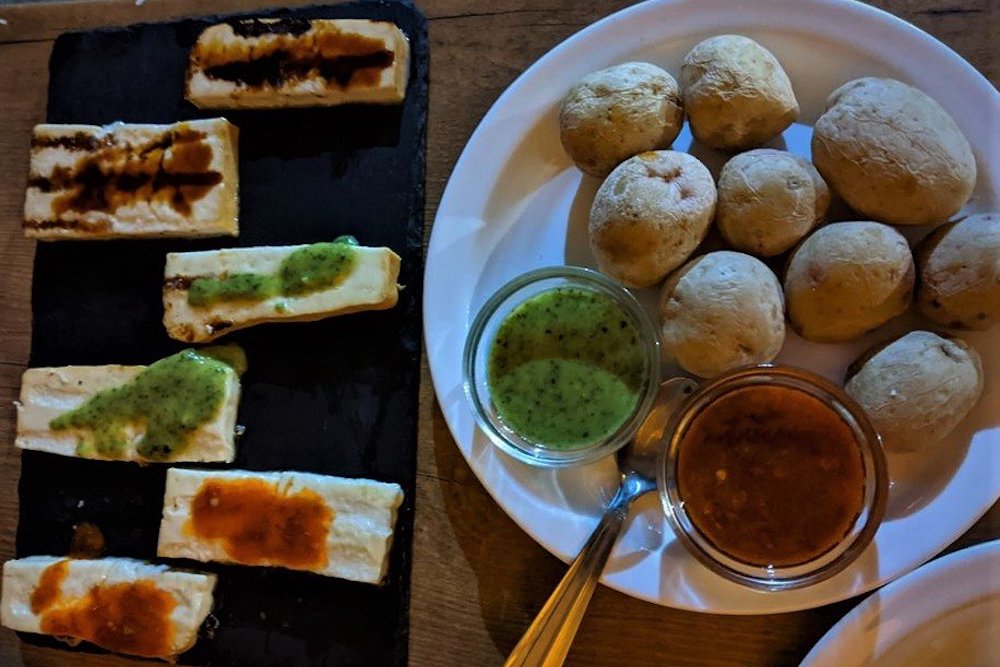
Traditional Canarian dishes
Among the most notable traditional dishes of Canarian gastronomy is "gofio", a toasted flour made from cereals such as wheat or corn, which is used as a base in a variety of dishes, from soups to desserts. . "Puchero canario" is another popular dish, a type of Canarian stew that combines meat, chickpeas, potatoes and vegetables in a tasty and comforting broth.
"Mojo" is a spicy sauce characteristic of Canarian cuisine that is served with a variety of dishes, from wrinkled potatoes to grilled fish. There are two main types of mojo: "mojo rojo", made with red peppers, and "mojo verde", made with cilantro or parsley. Both are delicious and add a unique touch of flavor to any meal.
And, for sweet lovers, Canarian gastronomy offers a variety of traditional desserts and sweets that satisfy any craving. The "bienmesabe" is a popular dessert made with almonds, honey, sugar and egg, while the "quesillos" are small flans made with condensed milk and eggs, flavored with lemon and cinnamon.
The "frangollo" and "truchas" are other typical desserts of the Canary Islands. Frangollo is a pudding made with corn flour, milk, sugar and lemon zest, while trout are pastries filled with angel hair or sweet potato and then fried until golden and crispy.
Gofio, a toasted cereal flour, is a basic ingredient in Canarian cuisine and is used in a variety of dishes, from soups to desserts. Canary Islands bananas are also famous for their sweet flavor and can be enjoyed in a variety of ways, from main dishes to desserts.
Discover these islands near the African continent and travel to a dream place
The Canary Islands stand as a paradisiacal destination in the middle of the Atlantic Ocean, fleeing from the metropolitan area of the Iberian Peninsula and offering a unique experience that combines its subtropical climate, impressive landscapes and rich cultural history. From the traces of the ancient Guanches to Spanish colonial architecture, these islands have a fascinating heritage. This jewel in the middle of the ocean deserves to be cared for and protected to continue providing us with these paradisiacal places, which is why we proclaim responsible and sustainable tourism, supporting local products and respecting conservation standards. The Canary Islands are much more than a tourist destination; They are a true paradise waiting to be discovered and enjoyed by those looking for an unforgettable spring getaway.
FREQUENTLY ASKED QUESTIONS ABOUT THE CANARY ISLANDS
What is the climate in the Canary Islands?
The climate in the Canary Islands is oceanic subtropical, characterized by mild temperatures throughout the year. They are popularly known as "the islands of eternal spring" due to their pleasant and stable climate. Average temperatures range between 20 and 25 degrees Celsius during spring, making it one of the most attractive destinations to escape the cold winter or the stifling heat of summer.
What are the main tourist activities in the Canary Islands?
The Canary Islands offer a wide variety of tourist activities for all tastes and ages. Among the most popular activities are hiking through its spectacular volcanic landscapes, whale and dolphin watching, practicing water sports such as surfing, diving and windsurfing, as well as exploring its rich history and culture through its museums and archaeological sites.
What is the best time to visit the Canary Islands?
Given its subtropical climate, the Canary Islands are an ideal destination to visit at any time of the year. However, spring and fall tend to be the most popular seasons due to milder temperatures and fewer tourists compared to the summer months.


















































